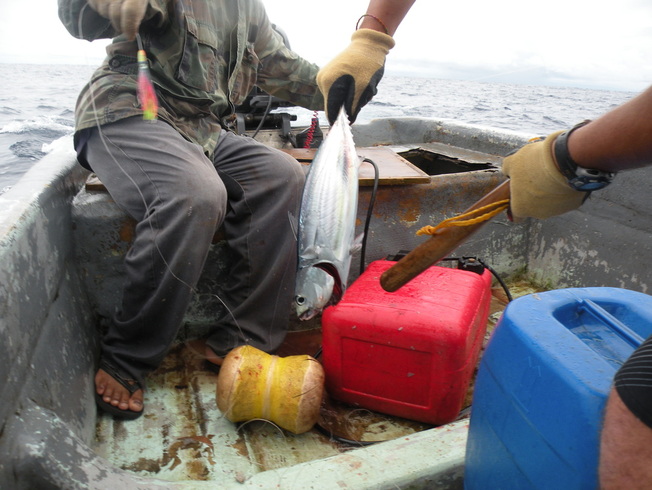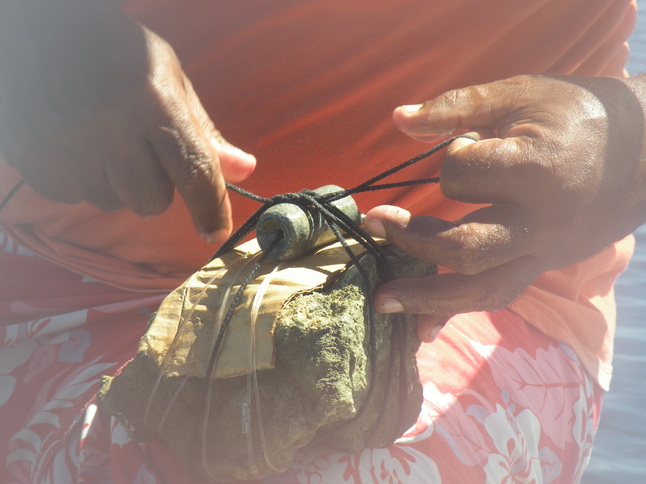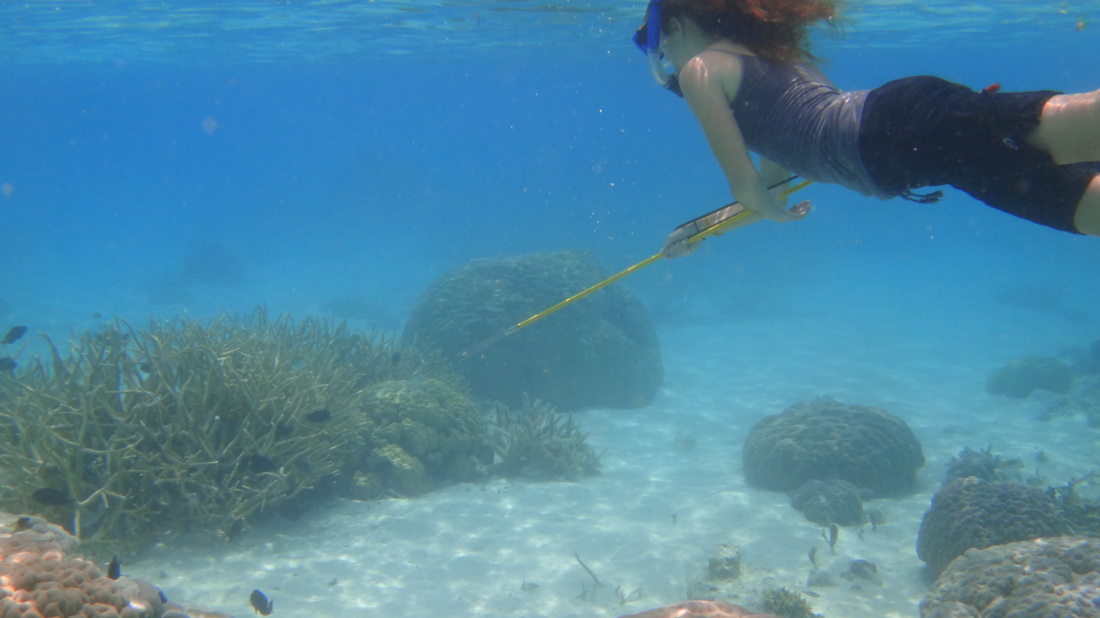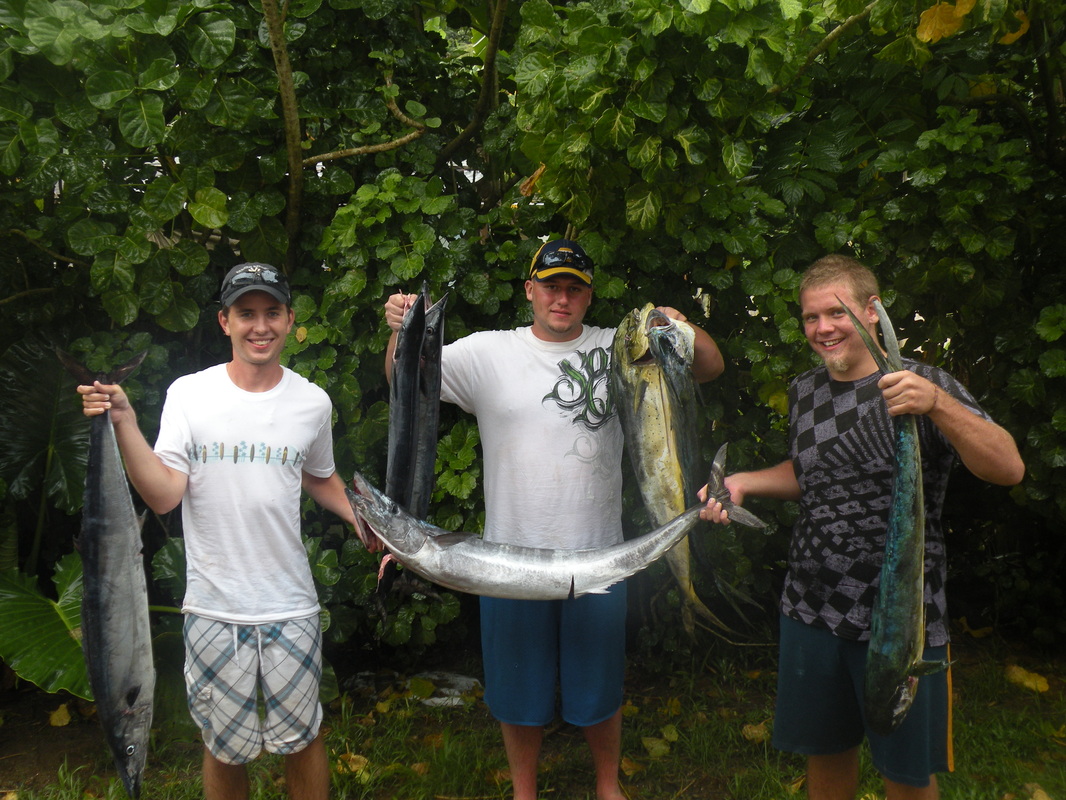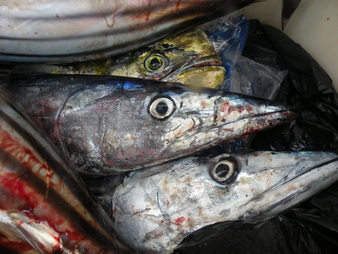
One of my favorite activities during my time in Micronesia has been fishing. I have been fortunate to be surrounded by individuals who love fishing more than I thought was humanly possible. My previous fishing experience consisted of the typical cast and reel at lakes. The fishing I found here is in a completely different ballpark. I have taken part of three different types of fishing. They are:
Trolling
This is the most common type of fishing for non-commercial fishermen. While some have high-tech rods for trolling, the standard is using a hand line. Lines are wrapped around buoys which have been carved into an hourglass shape.
How It’s Done:
To find the fish, you look for groups of birds. Once a group has been spotted, it’s pretty simple – you let the line out the distance you want, with the hook and lure at the end, and hold onto the other end. Usually you face the back of the boat with the line wrapped around your hand closest to the inside of the boat and the outer hand holding the line, feeling for pressure. What happens if you catch a monster fish? You hold on! When we are trolling for bigger fish and have the larger hooks on I tend to push my feet up against the ribs of the boat so I don’t fly overboard in case I hook a monster.
Dangers:
The most obvious danger is being thrown overboard after hooking a gigantic fish. Drowning is possible if the line gets stuck around your hand and the fish dives. While this might be the most dramatic danger, what happens more often is the boat’s engine dying in the open ocean. With strong currents, a boat can be taken hundreds of miles. Mr. B told me how his cousin and two friends drifted all the way to the Marshall Islands for 24 days, surviving on one coconut and tiny creatures growing on driftwood. This past weekend, one of the groups of people going to camp on Ahnd Atoll were extremely lucky when the engine died in the channel instead of in the open ocean. They still might be drifting! Truly, the ocean is a beast and shows no mercy. You really have no idea what can happen out there.
Pros:
You catch the biggest fish this way and if you follow a school of fish around you can catch boatloads of fish - literally.
Cons:
It uses the most gas and if you can’t find birds or the fish aren’t biting it’s a real bummer.
Bottom Fishing
This type of fishing is almost always done inside the reef.
How It’s Done:
Here instead of lures you use bait (Skipjack tuna is the best bait), and weight your line to the bottom. Back in October, Sheldon, a Kapinga man (from the island Kapingamarangi, an outer island of Pohnpei State), taught us drop stone fishing. This is how it works: you put bait (skipjack) on a hook, put the hook on a piece of cardboard, (a little bigger than palm size) fill it with chum, fold the cardboard over, wrap the line and cardboard around a rock and tie a special knot. You throw the whole package overboard and when it reaches how many fathoms you want it to go you pull up real fast. It releases the rock and chum, while the hook lingers. Lots of snafus happen as you can imagine, but if fish are biting it works very well.
Dangers:
This is easily the safest of the three types of fishing here. I suppose you could still get your hand stuck in the line and be thrown overboard but I have never heard of that happening. Most of the dangers of the ocean are avoided by staying inside the reef.
Pros:
It doesn’t cost as much gas and if you find a good spot where the fish are biting, you can be pulling for hours.
Cons:
Most of the best fish (in my opinion: Wahoo and Mahi Mahi) are found outside the reef. It also can get pretty boring if the fish aren’t biting and you’re just sitting there. It’s also worth mentioning that those who get sea sick are much more likely to get sick sitting on a stationary boat rather than trolling around in the ocean.
This type of fishing is almost always done inside the reef.
How It’s Done:
Here instead of lures you use bait (Skipjack tuna is the best bait), and weight your line to the bottom. Back in October, Sheldon, a Kapinga man (from the island Kapingamarangi, an outer island of Pohnpei State), taught us drop stone fishing. This is how it works: you put bait (skipjack) on a hook, put the hook on a piece of cardboard, (a little bigger than palm size) fill it with chum, fold the cardboard over, wrap the line and cardboard around a rock and tie a special knot. You throw the whole package overboard and when it reaches how many fathoms you want it to go you pull up real fast. It releases the rock and chum, while the hook lingers. Lots of snafus happen as you can imagine, but if fish are biting it works very well.
Dangers:
This is easily the safest of the three types of fishing here. I suppose you could still get your hand stuck in the line and be thrown overboard but I have never heard of that happening. Most of the dangers of the ocean are avoided by staying inside the reef.
Pros:
It doesn’t cost as much gas and if you find a good spot where the fish are biting, you can be pulling for hours.
Cons:
Most of the best fish (in my opinion: Wahoo and Mahi Mahi) are found outside the reef. It also can get pretty boring if the fish aren’t biting and you’re just sitting there. It’s also worth mentioning that those who get sea sick are much more likely to get sick sitting on a stationary boat rather than trolling around in the ocean.
Spear Fishing
Out of these three types of fishing, this one might be the most difficult and have the most variables.
How It’s Done:
There’s not too much to it – you find a reef, jump in the water with your spear, find a fish, and try to spear it. The spears are three metal prongs at one end, a long, skinny, plastic tube, and a circle of rubber at the other end. You place the rubber between your thumb and pull up on the rubber on the pole as far as you can, letting go when you attempt to spear a fish. It’s possible to spear fish in the day but it is very difficult as the fish see you and are very fast. The best time to spear fish is at night with a new moon – the moon is so bright here many fish stay awake, thinking it’s still day time when there's a full moon. With a flashlight in one hand and a spear in the other, you hover over the fish, not shining the light directly on it, then shine the light and spear in one fluid motion. It takes a good deal of practice to become a successful spear fisherman.
Dangers:
Being actually in the water presents natural risks, especially at night. For those who love Shark Week, yes there are sharks. But they don’t want to eat you, they want your fish. Many times they stalk you, waiting to eat your catch. Sharks really are lazy creatures and I hate them for it! When spear fishing, many people stick a rope through the gills of the fish, and hold the fish out on a line while they continue to fish instead of swimming to the boat and throwing the fish in there. Obviously it’s not the best idea to swim around with bloody fish attached to you. Almost every shark “attack” spear fishing story I’ve heard has been sharks trying to eat fish attached to one of these lines and accidentally getting a bite of the fisherman. Beyond sharks, there’s other dangers such as strong currents and fishermen getting stuck in coral and drowning trying to find fish hiding there. It’s also worth mentioning getting speared by other fishermen, though thankfully I haven’t witnessed that!
Pros:
It’s fun to swim around in the ocean and see with your eyes which fish you want to eat, rather than waiting for a bite on a line.
Cons:
While sharks just want your fish, it still is pretty sketchy to be stalked by sharks – especially at night when you can’t see them. Also, unless you find a really good reef the total catch isn’t usually as high as trolling or bottom fishing.
Out of these three types of fishing, this one might be the most difficult and have the most variables.
How It’s Done:
There’s not too much to it – you find a reef, jump in the water with your spear, find a fish, and try to spear it. The spears are three metal prongs at one end, a long, skinny, plastic tube, and a circle of rubber at the other end. You place the rubber between your thumb and pull up on the rubber on the pole as far as you can, letting go when you attempt to spear a fish. It’s possible to spear fish in the day but it is very difficult as the fish see you and are very fast. The best time to spear fish is at night with a new moon – the moon is so bright here many fish stay awake, thinking it’s still day time when there's a full moon. With a flashlight in one hand and a spear in the other, you hover over the fish, not shining the light directly on it, then shine the light and spear in one fluid motion. It takes a good deal of practice to become a successful spear fisherman.
Dangers:
Being actually in the water presents natural risks, especially at night. For those who love Shark Week, yes there are sharks. But they don’t want to eat you, they want your fish. Many times they stalk you, waiting to eat your catch. Sharks really are lazy creatures and I hate them for it! When spear fishing, many people stick a rope through the gills of the fish, and hold the fish out on a line while they continue to fish instead of swimming to the boat and throwing the fish in there. Obviously it’s not the best idea to swim around with bloody fish attached to you. Almost every shark “attack” spear fishing story I’ve heard has been sharks trying to eat fish attached to one of these lines and accidentally getting a bite of the fisherman. Beyond sharks, there’s other dangers such as strong currents and fishermen getting stuck in coral and drowning trying to find fish hiding there. It’s also worth mentioning getting speared by other fishermen, though thankfully I haven’t witnessed that!
Pros:
It’s fun to swim around in the ocean and see with your eyes which fish you want to eat, rather than waiting for a bite on a line.
Cons:
While sharks just want your fish, it still is pretty sketchy to be stalked by sharks – especially at night when you can’t see them. Also, unless you find a really good reef the total catch isn’t usually as high as trolling or bottom fishing.
I couldn’t write a post about fishing in Pohnpei without talking about how these waters are being drastically exploited. Mr. B, an avid fisherman who has been fishing the Pohnpeian waters for over 50 years, provides excellent testimony to how much has changed. I strongly suspect there has been an incredible amount of backroom deals between officials from the FSM and foreign countries, allowing these waters to be over fished. The use of nets has been disastrous as the net catches everything in the ocean – and what isn’t wanted is thrown overboard, dead. Even John in his twelve years here has seen a drop in the number of fish. Mr. B used to go trolling and always catch a 50+ lb. Yellowfin Tuna – now that happens maybe a few times a year.
Overall fishing is really fun though it’s not for the faint of heart. After a day full of salt and sun, I’m always thankful to arrive on land and not have to go out the next day. Besides the fun, it’s worth the effort every time when it leads to fish taco night!
Overall fishing is really fun though it’s not for the faint of heart. After a day full of salt and sun, I’m always thankful to arrive on land and not have to go out the next day. Besides the fun, it’s worth the effort every time when it leads to fish taco night!
